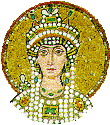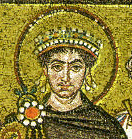Ken Pennington, “Caesaropapism,” The New Catholic Encyclopedia: Supplement 2010 (2 Vols. Detroit: Gale Publishers 2010) 1.183-185
Caesaropapism
The term
is a modern usage and has been generally applied to Christian rulers and
societies, especially the medieval Byzantine Empire. Justus Henning Böhmer
(† 1749), a gifted Protestant canonist who made significant contributions to
the history of Catholic canon law, may have been the first to coin it. In his work on Protestant canon law
Böhmer discussed two forms of “perverse human
long-standing customs” that he considered
 dangerous for a just society: “papo-caesaria” in the
church legislated in matters that
pertained to the secular state and “caesaro-papia,” in
which a secular sovereigns promulgated laws that invaded territory that should
be the proper jurisdiction of the church.
He mentioned that an example of “caesaro-papia”
could be seen in the first book of the Emperor Justinian’s book of laws, the Codex. Indeed, the
first book of Justinian’s Codex contains
a long list of imperial constitutions from the Emperor Constantine to Justinian
that regulated ecclesiastical affairs. In
contrast to Böhmer’s measured definition of
“Caesaropapism,” later scholars and reference works defined “Caesaropapism” very
narrowly and deformed Böhmer’s careful definition. First, they used the term primarily to define
the constitutional structure of the Byzantine Empire between the reign of the
Emperor Justinian († 565) and the fall of the Empire to the Ottoman Turks in
1453. Then they argued that the
Byzantine state was a regime in which the sovereign was the head of the church
and the state and that he exercised absolute authority and jurisdiction over
the ecclesiastical realm. They defined
this form of government as Caesaropapist. In response historians have rightly pointed
out that no Byzantine emperor ever held absolute authority over the secular and
the ecclesiastical institutions of the Empire.
Although Byzantine emperors did have extensive jurisdictional power over
the church, they rarely promulgated legislation that dictated dogmatic
norms. A consequence of this historiographic development has been that Caesaropapism has
been discredited as a useful concept for historical analysis.
dangerous for a just society: “papo-caesaria” in the
church legislated in matters that
pertained to the secular state and “caesaro-papia,” in
which a secular sovereigns promulgated laws that invaded territory that should
be the proper jurisdiction of the church.
He mentioned that an example of “caesaro-papia”
could be seen in the first book of the Emperor Justinian’s book of laws, the Codex. Indeed, the
first book of Justinian’s Codex contains
a long list of imperial constitutions from the Emperor Constantine to Justinian
that regulated ecclesiastical affairs. In
contrast to Böhmer’s measured definition of
“Caesaropapism,” later scholars and reference works defined “Caesaropapism” very
narrowly and deformed Böhmer’s careful definition. First, they used the term primarily to define
the constitutional structure of the Byzantine Empire between the reign of the
Emperor Justinian († 565) and the fall of the Empire to the Ottoman Turks in
1453. Then they argued that the
Byzantine state was a regime in which the sovereign was the head of the church
and the state and that he exercised absolute authority and jurisdiction over
the ecclesiastical realm. They defined
this form of government as Caesaropapist. In response historians have rightly pointed
out that no Byzantine emperor ever held absolute authority over the secular and
the ecclesiastical institutions of the Empire.
Although Byzantine emperors did have extensive jurisdictional power over
the church, they rarely promulgated legislation that dictated dogmatic
norms. A consequence of this historiographic development has been that Caesaropapism has
been discredited as a useful concept for historical analysis.
When
he coined the term Böhmer did not define “Caesaro-papia” as a sovereign’s absolute authority over
ecclesiastical matters nor did he connect the concept exclusively with
Byzantium. He had used Justinian’s Codex as an example of what he meant by the term. It could still be a useful term if, as Böhmer did, it would describe
 the authority of a lay ruler
to participate in the governance of the church
in a society. Theocracy can be
used to describe a variety of different governing systems in which religious
leaders hold secular political power to varying degrees, but no word exists in
English or in other languages to define the opposite system of governance. Böhmer’s definition
of Caesaropapism could fulfill that lacuna.
the authority of a lay ruler
to participate in the governance of the church
in a society. Theocracy can be
used to describe a variety of different governing systems in which religious
leaders hold secular political power to varying degrees, but no word exists in
English or in other languages to define the opposite system of governance. Böhmer’s definition
of Caesaropapism could fulfill that lacuna.
The king (regnum) and the priest (sacerdotium) have always been two centers of power and authority in human society and government. Until modern times the most common form of government in the world unified these two powers in one way or another. In the Judeo-Christian tradition the figure of a priest-king had great antiquity. Melchisedech was a mysterious figure in the book of Genesis who was described as a priest of the most high God and the king of Salem (Genesis 14:18). Moses was another archetype of the priest-king. Later popes, especially Pope Innocent III (1198-1216) and his successors, used Melchisedech to prefigure and to justify papal temporal power. In the high Middle Ages popes did exercise extensive secular power in the papal states (Patrimonium Petri). In those lands the popes were theocratic rulers. In several Moslem lands today theocratic governments are in place.
The figure of the king-priest also had deep roots. In the ancient world rulers often held religious as well as secular duties and powers. For the development of the concept of Caesaropapism, the king-priest, Rome is of great importance. The title and authority of the Pontifex maximus (Great Priest) over Roman religious institutions gradually began to be taken over by secular rulers during the late Roman republic. The first to do so seems to have been Julius Caesar who was elected Pontifex maximus in 63 BC by the Roman senate. As the Roman state was transformed into a monarchy, in addition to their other titles, emperors adopted the title of Pontifex maximus (Great Priest). When the first Christian Emperor Constantine (306-337) decided to engage in the controversy surrounding the heresy of Arianism, he quite naturally considered it within his imperial authority ― because he was the pontifex maximus ― to call the Council of Nicaea and to preside over its deliberations. In his mind it was the Christian sovereign’s right and duty to guide his Church. Christian emperors continued to use the title of Pontifex maximus until the Emperor Gratian refused to accept the title in 376 or 379. No later eastern emperor used the title, and the last vestige of a Christian emperor’s connection with Roman religion vanished. Even though the title died, the idea that the Byzantine emperor should play a large role in ecclesiastical affairs did not. At a very early date, however, the bishops of Rome, however, adopted the title and it remained a papal title until modern times.
Within the Eastern Christian world the tradition of the Eastern Roman emperors exercising considerable jurisdiction over ecclesiastical affairs and institutions that had begun with Constantine continued for centuries. Byzantine emperors did call church councils and issue extensive legislation that affected the church. The Emperor Justinian (527-565) legislated in many areas of Christian life, most importantly perhaps, in marriage. His laws changed many norms of marriage and divorce. The appointment of the Patriarch of Constantinople needed the emperor’s approval. It can be said that in the Eastern Orthodox Christian tradition rulers exercised much more authority and jurisdiction over ecclesiastical affairs than in the West. The Russian czars, for example, traditionally exercised considerable jurisdiction over the Orthodox Church.
In the West Christian rulers also legislated in ecclesiastical matters during the early Middle Ages and exhibited some aspects of a limited Caesaropapism. Charlemagne (Charles the Great 768-814) issued a large number of capitularies (laws) that touched many areas of church discipline. He also involved himself in dogmatic and liturgical questions. Until the twelfth century, Charlemagne’s relationship to the church and the relationship of other Western princes to ecclesiastical institutions was not unusual in the West. The border between secular and ecclesiastical authority was blurred. Kings meddled in the affairs of the church on a regular basis and thought they had the right to do so. The beginnings of a separation of church and state in Western Christendom began in the eleventh century, during a period that has been called the Investiture Controversy, the Gregorian Reform Movement, or a “papal revolution.” A series of popes from Pope Leo IX to Pope Gregory VII promulgated conciliar decrees and issued papal decretals that established the independence of the clergy and ecclesiastical institutions from the lay jurisdiction. It took almost two centuries before these new principles were generally accepted by European Christian princes.
The high medieval paradigm of an independent church lasted until the Protestant Reformation. When he broke away from Rome, King Henry VIII of England assumed the leadership of the Anglican church. He and his successors remain the titular head of the Anglican church until the present day. Other Protestant sovereigns also exercised jurisdiction over their churches. Luther’s theology of the “two-kingdoms” dictated that the church had no legislative authority and jurisdiction. Consequently, Protestant princes exercised significant jurisdictional and legislative authority over the churches in their realms.
A similar movement occurred in Catholic countries. From the sixteenth century on, European Catholic princes extracted concessions from Rome that enhanced their control of their national churches. In France and Spain kings reached concordats (agreements) with Rome that granted them far more authority over their national churches than they had ever exercised since the Investiture Controversy. With the Concordat of Bologna in 1516, concluded between the French King Francis I and Pope Leo X, the French king and his successors were granted rights over the appointment of clergy. The king could even restrict appeals to Rome. Historians have called the movement in France to restrict papal authority over the French church and to enhance the rights of French bishops and the French king, Gallicanism. In 1523 Pope Hadrian II granted the Spanish king the same right to appoint ecclesiastical benefices as the King of France had obtained. In the eighteenth century, the papacy concluded concordats with Savoy, Spain and Portugal, granting sovereigns significant authority over ecclesiastical institutions. All of these developments in Latin Christendom can be described as examples of Böhmer’s definition of Caesaropapism.
Bibliography: Justus Henning Böhmer, Ius ecclesiasticum protestantium: Usum hodiernum iuris canonici iuxta seriem Decretalium ostendens et ipsis rerum argumentis illustrans (5 vols. Halae-Magdeburgicae [Halle-Magdeburg]: Impensis Orphanotrophei, 1756-1789) 1.10-11. “Caesaropapism,” The Oxford Dictionary of the Christian Church, ed. F.L. Cross (London: Oxford University Press, 1958) 215. “Caesaropapismus,” dtv-Wörterbuch der Kirchen-geschichte ed. Georg Denzler and Carl Andresen (München: Deutscher Taschenbuch Verlag, 1982) 153. Deno J. Genakopolos, “Church and State in the Byzantine Empire: A Reconsideration of the Problem of Caesaropapism,” Church History 34 (1965) 381-403, reprinted in Byzantine East and Latin West: Two Worlds of Christendom in Middle Ages and Renaissance: Studies in Ecclesiastical and Cultural History (New York: Barnes & Noble, 1966). Brian Tierney, The Crisis of Church and State 1050-1300 (New York: Prentice Hall, 1964, reprinted Toronto: University of Toronto Press, 1989). Gilbert Dagron, Emperor and Priest: The Imperial Office in Byzantium, Translated by Jean Birrell (Past and Present Publications.; Cambridge: Cambridge University Press, 2003; Original title: Empereur et prêtre: Étude sur le “césaropapism” byzantine [Paris: Éditions Gallimard, 1996]). John Witte, Jr. Law and Protestantism: The Legal Teachings of the Lutheran Reformation (Cambridge: Cambridge University Press, 2002).
Kenneth Pennington The Catholic University of America, Washington, D.C.